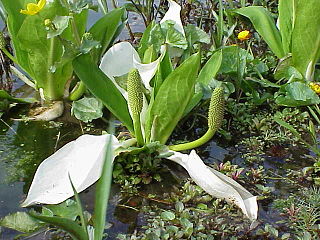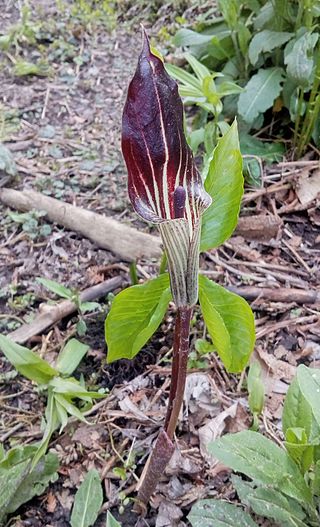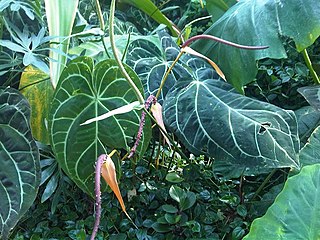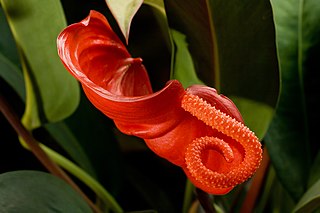
The Araceae are a family of monocotyledonous flowering plants in which flowers are borne on a type of inflorescence called a spadix. The spadix is usually accompanied by, and sometimes partially enclosed in, a spathe. Also known as the arum family, members are often colloquially known as aroids. This family of 114 genera and about 3,750 known species is most diverse in the New World tropics, although also distributed in the Old World tropics and northern temperate regions.

In botany, a spadix is a type of inflorescence having small flowers borne on a fleshy stem. Spadices are typical of the family Araceae, the arums or aroids. The spadix is typically surrounded by a leaf-like curved bract known as a spathe. For example, the "flower" of the well known Anthurium spp. is a typical spadix with a large colorful spathe.

Philodendron is a large genus of flowering plants in the family Araceae. As of June 2013, the Plants of the World Online accepted 621 species; other sources accept different numbers. Regardless of number of species, the genus is the second-largest member of the family Araceae, after genus Anthurium. Taxonomically, the genus Philodendron is still poorly known, with many undescribed species. Many are grown as ornamental and indoor plants. The name derives from the Greek words philo- 'love, affection' and dendron 'tree'. The generic name, Philodendron, is often used as the English name.

Spathiphyllum is a genus of about 60 species of monocotyledonous flowering plants in the family Araceae, native to tropical regions of the Americas and southeastern Asia. Certain species of Spathiphyllum are commonly known as spath or peace lilies.

Zantedeschia is a genus of eight species of herbaceous, perennial, flowering plants in the aroid family, Araceae, native to southern Africa(from South Africa northeast to Malawi). The genus has been introduced, in some form, on every continent.

Lysichiton is a genus in the family Araceae. These plants are known commonly as skunk cabbage or less often as swamp lantern. The spelling Lysichitum is also found. The genus has two species, one found in north-east Asia, the other in north-west America.

Arisaema triphyllum, the Jack-in-the-pulpit, is a species of flowering plant in the arum family Araceae. It is a member of the Arisaema triphyllum complex, a group of four or five closely related taxa in eastern North America. The specific name triphyllum means "three-leaved", a characteristic feature of the species, which is also referred to as Indian turnip, bog onion, and brown dragon.

Zamioculcas is a genus of flowering plants in the family Araceae, containing the single species Zamioculcas zamiifolia. It is a tropical herbaceous perennial plant, and is native to eastern Africa, including Kenya, KwaZulu-Natal, Malawi, Mozambique, Tanzania, and Zimbabwe. Its common names include Zanzibar gem, ZZ plant, Zuzu plant, aroid palm, eternity plant and emerald palm. It is grown as a houseplant, mainly because it has attractive glossy foliage and is easy to care for. Zamioculcas zamiifolia is winter-hardy in USDA Zones 9 and 10.

Spathiphyllum wallisii, commonly known as peace lily, white sails, or spathe flower, is a very popular indoor house plant of the family Araceae. The genus name means "spathe-leaf", and the specific epithet is named after Gustav Wallis, the German plant collector. It was first described in 1877.
Carlephyton is a genus of four species in the family Araceae, all endemic to Madagascar.

Lagenandra is a genus of aquatic flowering plants in the aroid family, Araceae, endemic to the Indian Subcontinent. The genus has gradually become more known through the aquascaping and aquarium hobby, in which several related Araceae genera are already highly prized and grown on a large scale ; Lagenandra, however, is still relatively rare in cultivation or private collections.

Thaumatophyllum bipinnatifidum is a plant in the genus Thaumatophyllum, in the family Araceae. Previously it was classified in the genus Philodendron within subgenus Meconostigma. The commonly used names Philodendron bipinnatifidum and Philodendron selloanum are synonyms. This plant is native to South America, namely to Brazil, Bolivia, Argentina, and Paraguay, but is also cultivated as a landscape plant in tropical, subtropical and warm temperate climates.

Anthurium andraeanum is a flowering plant species in the family Araceae that is native to Colombia and Ecuador. It is a winner of the Royal Horticultural Society's Award of Garden Merit.

Anthurium crystallinum is a species of flowering plant in the family Araceae, native to rainforest margins in Central and South America, from Panama to Peru. Growing to around 90 cm (35 in) tall and wide, A. crystallinum is an epiphytic perennial evergreen, known for its dark green and velvety-textured, heart-shaped leaves featuring prominent white veining, and somewhat resembles a smaller version of Anthurium magnificum. The inflorescence is a somewhat visually-nondescript spathe with a pale green spadix, appearing throughout the year.

Thaumatophyllum xanadu is a perennial plant belonging to the arum family Araceae and the genus Thaumatophyllum, formerly classified under the Meconostigma subgenus of Philodendron. This plant is native to Brazil, but is widely cultivated as a landscape plant in tropical, subtropical and warm temperate climates.

Anthurium clarinervium is a species of flowering plant in the family Araceae native to Chiapas, Mexico. The Anthurium genus is known to contain approximately 1,000 species, resulting in one of the most diverse Central American tropical plant genera.

Anthurium scherzerianum, the flamingo flower or pigtail plant, is a species of Anthurium native to Costa Rica. It has gained the Royal Horticultural Society's Award of Garden Merit as an ornamental houseplant, kept at 15 °C (60 °F) or higher. It is naturally an epiphyte, growing on trees in the rainforest.
Thaumatophyllum adamantinum is a plant in the genus Thaumatophyllum, in the family Araceae. It is native to South America, namely to Southeast Brazil, but is also cultivated as a houseplant in cooler climates.

Anthurium wendlingeri is a species of aroid plant, in the genus Anthurium, found from Central to South America, from SE Nicaragua to NW Colombia. It grows in moist, montane tropical habitats as an epiphyte. Unique among its genus, A. wendlingeri has long, pendant and strap-like leaves, and can have a slightly velvety appearance.
Anthurium lentii is a species of flowering plant in the family Araceae, native to Colombia, Costa Rica and Panama. It grows in wet tropical habitats, and is a member of section Digitinervium.



























